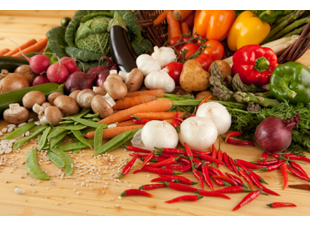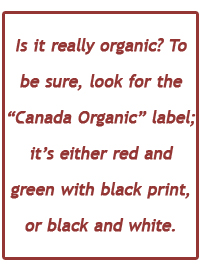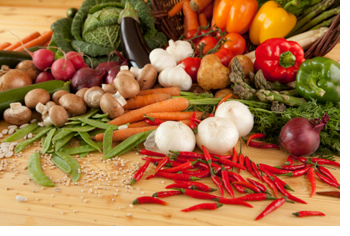 In the supermarket, It’s becoming increasingly common to see a permanent section dedicated to ?natural? or ?organic? foods. What makes a food organic, and why are these foods gaining such popularity? Are they worth the extra cost over ?conventionally grown? foods?
In the supermarket, It’s becoming increasingly common to see a permanent section dedicated to ?natural? or ?organic? foods. What makes a food organic, and why are these foods gaining such popularity? Are they worth the extra cost over ?conventionally grown? foods?
What?
What exactly does it mean for a food to be grown organically? Organic vegetables are those grown without the use of synthetic chemical sprays as pesticides, herbicides, and fungicides; organic meat, fish, and animal products come from animals raised without growth hormones, antibiotics, or conventionally sprayed grains in their diets. Additionally, animals grown under organic guidelines require regular access to pastureland and the ability to move freely in each direction.
Why?
Much of the controversy surrounding organically grown foods stems from the debate over the toxicity of conventional sprays. There’s additional disagreement over whether there is a greater nutritional potential in organic foods.
The most commonly studied sprays are the organophosphates, actually a class of chemicals from which many conventional sprays are derived. It’s relatively undisputed that organophosphates are potentially toxic when ingested in minute quantities, especially for infants, children, small pets, and the elderly. In addition, there is the issue of direct toxicity for those, like farmers, who handle organophosphate sprays. Examples of effects include teratogenicity (potential for birth defects) and nervous system diseases like Parkinson’s.
Examples of effects include teratogenicity (potential for birth defects) and nervous system diseases like Parkinson’s.
With the conventional vs. organic debate, the biggest issue is whether there’s a similar toxicity in produce grown using conventional sprays. It’s difficult to assess, but a few items to ponder include the following.
Migratory birds have been found to carry levels of the types of pesticides that correlate with the pesticides used along their migration patterns. It’s uncertain whether this phenomenon is from pesticide exposure in the air, or from herbicide residue in the vegetation that the birds consume. Of course, the question does arise: if chemical residues can occur in birds due to the air they breathe and the food they eat, then could the same occur for other animals, including humans?
The National Research Council maintains that conventional spray residue is evident in young children’s bodies (typically stored in fat tissue), and that a period of organic food consumption reduced these chemical levels. However, studies of adult consumption of organic foods didn’t show the same chemical-reduction response.
 Regardless, it is a fact that chemical residues are usually stored in fatty tissue in our bodies. If chemical residue from conventional sprays were in our tissues, It’s interesting to contemplate whether ?burning fat? would cause a chemical release into the bloodstream. (Exercise is still good for you?instead, consider the quality of the fat you wish to burn!)
Regardless, it is a fact that chemical residues are usually stored in fatty tissue in our bodies. If chemical residue from conventional sprays were in our tissues, It’s interesting to contemplate whether ?burning fat? would cause a chemical release into the bloodstream. (Exercise is still good for you?instead, consider the quality of the fat you wish to burn!)
The nutritional potential of organic foods is also a subject laden with controversy. Some US-based scientific studies claim negligible benefit; however, other studies, including several from Europe, maintain that organic foods possess higher values of desirable health-promoting complexes like antioxidants and fatty acids. Additionally, some people claim a taste difference between organically grown and conventionally grown foods; others note that organically grown vegetables decay far more slowly in the fridge than do conventionally-grown vegetables of the same type, age, and degree of ripeness. (However, personal experience isn’t considered significant evidence).
How Do I Know It’s Legit?
This is a great question! Any food item which is truly organically grown will always bear a certification label from a recognized organic food certification agency. (The exception is those spray-free beets that your grandmother grows in her backyard.) In Canada, in order for certification to be granted, the food must conform to the guidelines designated by the Canada Organic Standards (COS). These guidelines involve other factors besides the use of sprays or antibiotics. For example, genetically modified foods are a no-no, even if they have been grown according to organic growing standards. Additionally, animal products from certain animal growth situations, like feed lots where animals are overcrowded, are not considered organic.
In Canada, look for the ?Canada Organic? label (either red and green with black print, or black and white), redesigned last year, which are the official ?It’s organic? stamp. Certification is given through several different agencies, depending on the location of the organic farm. Note that if an item doesn’t have this label, then it is likely not organic, even if the food is advertised to be so.
 In the US, keep an eye out for the ?USDA Organic? labels on foods, signifying that the food complies with the US organic food standards.
In the US, keep an eye out for the ?USDA Organic? labels on foods, signifying that the food complies with the US organic food standards.
The Final Word
Besides the potential for health benefits, it is also evident that organic foods have a healthy impact on our ecosystem. No pesticides in the soil in which our vegetables are grown means no pesticide run-off into our rivers and streams. As a result, there aren’t the same negative effects on vulnerable water-dwelling species, such as frogs.
And then when you consider that this water?with or without pesticides?is evaporated into the atmosphere and re-falls on us as rain, then seeping into our water supply . . .well, you get the idea. Apparently, organic foods have the potential to positively impact both our bodies and the earth. Pass the organic beets, please!

